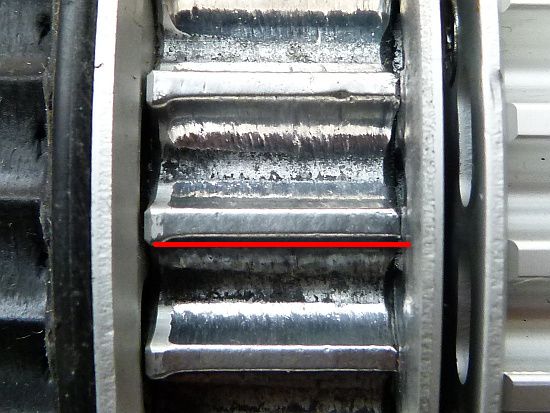This is a Strida LT if that matters. The other day I noticed that if the bicycle was rolled backwards on the rear wheel, the crank similarly rotated backwards.
So … what’s “normal” on the Strida? I uploaded a short video on YouTube to demonstrate.
https://www.youtube.com/watch?v=oDjUWiGRdPU&feature=youtu.be
BTW, I got that mixed up. When I rolled the bike forward on the rear wheel, the crank moves forward.
Nowadays we can find two types of freewheels on a Strida - but that’s not depending on the type (LT, SX, EVO) it is just the choice of the ordering distributor.

Both freewheel types (left Aluminium, right new plastic version, the one in the middle is outdated) do have more drag than common chain freewheels, perhaps the plastic version a little less than the metal version.
Btw - I don’t think that Sheldon ever had a Strida freewheel in hands…
Rolling a Strida forward it’s pretty normal that the cranks are moving, too.
Does it have sideways play?
(You need to release belt tension completely to check.)
How do the teeth look?
From left to right; brutally worn (old) plastic version, moderate worn Aluminium version, brandnew one.

A few details:
- As mentioned; this plastic freewheel is the worst we’ve ever seen

It appeared at Mike’s local bikestore http://www.dasfaltrad.at/ a while ago,
actually we’re wondering how this customer could ride the last two or three thousand kilometres…
However, we can see that the two tooth edges are totally disappeared (red lines) and due to that decreased the outer diameter dramatically - the belt will jump and it’ll be impossible to tighten.
Even the outer metal (bearing?) ring is partially visible, there’s not that much plastic left over.

There are many stages between the one above and that below; unfortunately there aren’t more samples handy right now.
- At the Aluminium version moved one tooth edge a little bit.
That’s usually no problem, of course it may be required to tighten the belt.

Thanks a million BlackStridaAustria.
I have one of the aluminum freewheels on the left. It looks identical to the one on sale at Strida Canada.
stridacanada.ca/?product=strida-freewheel
There is no lateral play and the teeth look fine. I’ve seen internal gear hubs with a lot of drag on a stand. Of course, performance with a load can be quite different than without. To be clear, I never noticed anything while riding the bike.
I’ve had years of reliable use with my Strida … I’m on my second rear tire and guesstimate a 1000 commutes. It’s one of the best purchases I’ve made. I never noticed the crank rotate before while rolling. I must naturally lean it onto the front wheel.
I don’t remember Sheldon ever talking about a Strida. Captain Bike would pop up every now and then in a folding bike forum to discuss a Raleigh 20.
You’re always welcome, thanks to you 
So…seem to be a lot kilometres for a freewheel…did you ride in rain, too?
And maybe you can tell something about your usual road conditions?
I don’t ride very far with the Strida. Say something like 3.5 km round trip per commute. Plus the occasional trip to the doctor, post office, or whatever during business hours. I have ridden in the rain and stuff. Although it’s not particularly wet here in Washington DC and I never ride the bike through deep water.
Roughly, what’s the expected lifespan of a Strida freehub?
Thanks 
Due to extremely different feedback I’m unable to tell, but I’ve developed even a theory about this theme:
According to me there must have been at least one series of freewheels which were not manufactured properly (guess it was bad anodizing), because:
Freewheel from Germany, ridden partially in rain, clean roads - teeth gone - 1500 km
Freewheel Greece, ridden at beach (!!) - moderate wear - ~ 6000 km (how could it withstand the sand?)
I remember also another, never ridden in rain - anyway just ~ 2000 km
(All Aluminium versions)
The last one I know was from France, a plastic one - just 1700 km, teeth OK but terrible play.
(My guess here is that this was an individual case due to a bad bearing.)
Generally one can say the more dirt in combination with water - the sooner is the wheel at he end of its lifespan. i don’t think that an Alloy freewheel could survive more than two, three thousand kilometres at Russian roads for example…
Ahhhh … alrighty then. It sounds like I should replace the freewheel.
Thanks again!
As long as you don’t have issues with belt jumping/twisting, no/less play and two visible edges per tooth you don’t need to hurry I think.
If the teeth are deformed it does make sense to change the belt at the same time btw.
No problem, please let us know if you want assistance for parts, tools, …whatever 



